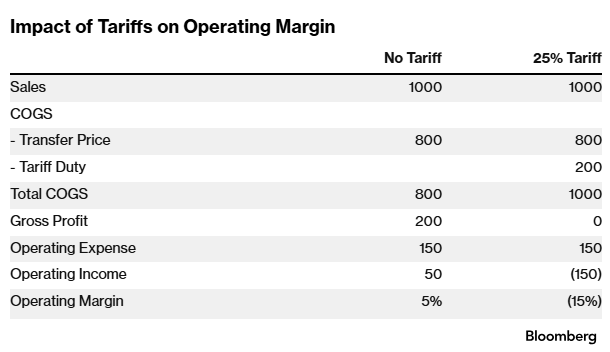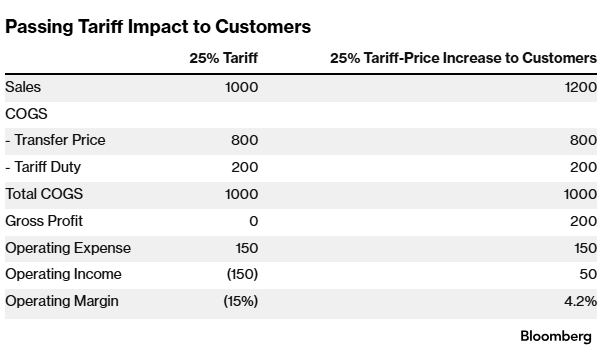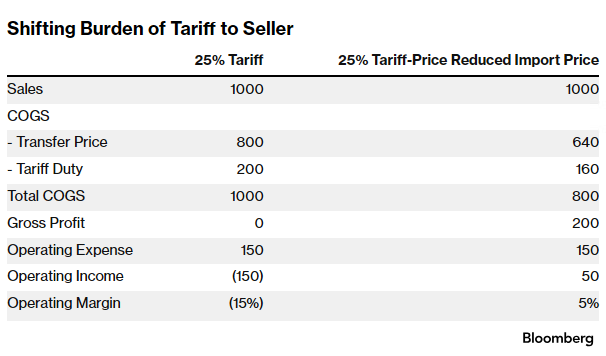The US tariffs threatened, imposed, deferred, and changed throughout 2025 have created uncertainty for transfer pricing compliance. As multinational enterprises that import affected goods from related companies strive to navigate the changing landscape on material, new tariffs, they face increased costs, affecting not only their profitability but also their transfer pricing compliance. MNEs may be required to lower the transfer price paid to related companies for imported goods to remain within the arm’s length profitability ranges expected by the IRS. The new tariffs complicate compliance as they are a material factor that could produce the need for true-up adjustments at year-end. Although these new tariffs are large enough to disrupt this year’s transfer pricing compliance efforts, timing issues may delay the full impact until next year.
Companies should take special care to evaluate tariff impact on transfer pricing results with ample time to make any true-up adjustments before year-end. Even if true-ups are not needed for 2025, taxpayers should begin addressing tariff impact to lay the groundwork for transfer pricing compliance next year.
Transfer Pricing and Customs Valuation
The substantial new tariffs, imposed by President Donald Trump and his administration, make transfer pricing and customs valuation compliance much more difficult and cause procedural issues with Customs and Border Patrol (CBP) and between the IRS and other tax authorities.
If the importer of record employs the “transactional” method for customs valuation, the transfer price also becomes the customs value used for the computation of tariffs. Further, the tariffs borne by a US importer (e.g., a US distributor) are inventoriable costs that reduce the operating income of that US importer.
Lookback Test
Using a “lookback test” to set provisional transfer prices throughout the year based on benchmarked results is a common practice for transfer pricing compliance. MNEs use provisional transfer prices during the year and then true-up the results sometime before or after year-end to ensure arm’s length profitability ranges. Evaluating transfer prices during the year and making any true-up adjustments before year-end is advisable to avoid additional administrative efforts.
Transfer Pricing True-Ups
A transfer pricing analysis of tangible goods compares the results in transactions between the controlled parties to the results in similar transactions between uncontrolled parties (the “comparables”) to determine whether the controlled transactions are arm’s length. Ideally, we would compare the price of goods in a controlled transaction to the price of goods in uncontrolled transactions, which is an application of the Comparable Uncontrolled Price (CUP) method. Most often, however, due to limited information on comparable goods pricing, companies apply the Comparable Profits Method (CPM) to evaluate the arm’s length nature of transactions. The CPM relies on financial data of comparable companies that are used to generate appropriate profit level indicators.
Since the comparables’ financial information will not be available for the year in question until a few months into the following year, taxpayers set provisional prices and true-up prices before or after year-end to report an arm’s length transfer price in transfer pricing documentation contemporaneous with the filing of a tax return.
Taxpayers can make true-up adjustments either before or after year-end. The taxpayer should have most of the information about sales price and volume and sales, general, and administrative expenses before year-end, but comparables data would not yet be available for the year in question. The comparables data is generally available before the extended due date of the tax return, but any adjustment after the financial books close would be subject to additional administrative efforts.
Transfer pricing adjustments made after the closing of the financial statements will cause a book-tax difference that must be listed on the taxpayer’s tax return. Further, Treas. Regs. §1.482-1(g)(3) requires an adjustment to conform the taxpayer’s accounts to reflect the allocations made under §482. These conforming adjustments may include the treatment of an allocated amount as a dividend or a capital contribution, or a repayment of the allocated amount without additional income tax consequences.
Impact of New Tariffs on Transfer Pricing Results
In 2025, the US raised tariffs on US imports to their highest average levels in recent history. The new tariffs generally range from a universal 10% tariff on virtually all goods imported into the US to a 100% tariff on some branded pharmaceuticals. Aside from the immensity of these tariffs, the manner in which they have been threatened, imposed, paused, and increased has made it difficult for companies to take decisive action. The proposed tariffs have been changed more than 70 times since January, when the new administration began.
The tariff cost generally becomes part of the inventoriable cost of the imported product that will be reflected in the cost of goods sold (COGS) for the imported product, thus reducing the taxpayer’s taxable income. The following chart demonstrates the impact of a 25% tariff entirely borne by US distributor on the profitability of that distributor, reducing its operating margin from 5% to a loss of 15%.
A negative 15% operating margin is unlikely to satisfy the IRS expectations for an appropriate return for a distributor, thus requiring an upward transfer pricing income adjustment to raise the US tested party’s results within the arm’s length range. This upward income adjustment can be made by reducing the import price for the goods purchased, thus requiring a downward customs valuation adjustment. Importers may make a voluntary “prior disclosure” of a violation to CBP to report a previously undeclared value or price adjustment in exchange for significantly mitigated customs penalties. Further, the importer may be entitled to a refund of tariffs paid.
Under US transfer pricing rules, an upward transfer pricing adjustment to the income of a US related party necessarily produces a downward adjustment to the income of the other transacting related party. The tax authority in the other involved country may not agree to the change. A US taxpayer can request the IRS’s assistance under a tax treaty to endeavor to achieve a downward adjustment to the income of the related party in a tax treaty country. This treaty mechanism, known as the Mutual Agreement Procedure (MAP), allows treaty partners to eliminate double taxation arising from transfer pricing disputes. Based on informal discussions with some tax authorities, US treaty partners may object to the reduced tax revenues caused by the self-enriching tariffs imposed by the US government. Shifting the cost of tariffs to other tax jurisdictions through transfer pricing mechanisms will likely lead to some difficult discussions among tax authorities in bilateral negotiations between treaty partners in the MAP or in bilateral advance pricing agreements as taxpayers seek to avoid double taxation.
Sharing the Impact of Tariffs
Although tariffs are initially borne by the importer-of-record, the importer-of-record can reduce the impact on its profits in three ways: 1) the importer can pass the tariff cost on to its customer in the form of a price increase, 2) the importer could share the tariff cost with the exporter in the supply chain through a reduced import price, or 3) a combination of 1 and 2.
The following chart shows the impact on the US distributor’s operating margin of increasing the price to customers of the entire 25% tariff.
The following chart shows the impact on the US distributor’s operating margin of reducing the import price to shift the burden of tariff costs to the seller in the other country.
True-Ups 2025
As the above illustrations demonstrate, the impact of the material tariffs could easily be large enough to disrupt transfer pricing compliance. In appropriate circumstances, passing it on to customers or pushing it back to a principal may be appropriate and will reduce the impact. However, taxpayers still need to review their transfer pricing for this year and consider true-up adjustments.
Luckily, a number of factors reduce the likely impact of tariffs this year:
- Tariffs have not been applicable for a full year.
- Many companies stockpiled pre-tariff inventory and are still selling non-tariff goods.
- Some companies have been able to pass on some of the tariff costs to customers and/or shared the cost with the exporting party.
- Most of the comparables also bear tariffs, thus moving the benchmark.
- Most transfer pricing methodologies use multi-year averaging.
For these reasons, the full impact of tariffs on transfer pricing compliance may not be felt until next year. Nonetheless, companies should still assess the impact of tariffs on their 2025 transfer pricing results and determine if and what true-up adjustments would be appropriate. A proactive assessment of true-ups enhances compliance with the arm’s length standard and reduces the likelihood of double taxation.Finally, this analysis can serve as the basis for making potential intercompany pricing adjustments moving into 2026.
This article does not necessarily reflect the opinion of Bloomberg Industry Group, Inc., the publisher of Bloomberg Law, Bloomberg Tax, and Bloomberg Government, or its owners.
Author Information
Steven C. Wrappe is the National Transfer Pricing Technical Leader at Grant Thornton LLP and an adjunct professor at New York University School of Law and University of California-Irvine School of Law. Justin Grocock is a Transfer Pricing Manager at Grant Thornton Advisors LLC in Chicago, IL. Marenglen Marku is a Ph.D. economist and principal in Transfer Pricing at Grant Thornton as well as an adjunct professor at DePaul University’s Kellstadt Graduate School of Business.
Grant Thornton LLP and GT Advisors (and their respective subsidiary entities) practice as an alternative practice structure in accordance with the American Institute of Certified Public Accountants Code of Professional Conduct and applicable law, regulations, and professional standards. Grant Thornton LLP is a licensed independent CPA firm that provides attest services to its clients, and GT Advisors and its subsidiary entities provide tax and business consulting services to their clients. GT Advisors and its subsidiary entities are not licensed CPA firms.
Write for Us: Author Guidelines
To contact the editors responsible for this story: Soni Manickam at smanickam@bloombergindustry.com;
Learn more about Bloomberg Tax or Log In to keep reading:
See Breaking News in Context
From research to software to news, find what you need to stay ahead.
Already a subscriber?
Log in to keep reading or access research tools and resources.





